![]()
![]()
![]()
Use LEFT and RIGHT arrow keys to navigate between flashcards;
Use UP and DOWN arrow keys to flip the card;
H to show hint;
A reads text to speech;
56 Cards in this Set
- Front
- Back
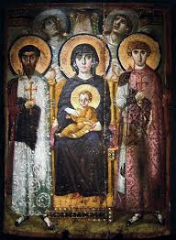
#54 Virgin (Theotokos) and Child between Saints Theodore and George - Early Byzantine Europe - 6th or early 7th century CE
Content: -Virgin Mary and child -gold halo -Saints on either side -angels at the corners -in apse of Hagia Sophia -Christ is small, but looks like an old man
Style: -gold halo is specific to Byzantine era -halo represents god-like figures, holiness, or sainthood -stylized face also specific to Byzantine art -football shaped eyes and long noses -feet dangle from clothing almost like the figures are hovering, common in medieval art -figures not at natural angles that make sense -hand positions are representative -mosaic in apse of Hagia Sophia |
Context: At this point in time in art, artists weren't completely aware of how to make the subjects realistic or perfect in a way that the ancient Greeks and Romans achieved. The faces were highly stylized in typical Byzantine style with long noses and large, football shaped eyes. This piece, like many others during the time, were full of icons. Some opposed the worship of images and icons and the representation of living things in holy places. There were Iconophiles, who worshiped those icons like the representation of the virgin Mary and Christ. And there were Iconoclasts, who believed that one shouldn't worship a representation of the living things. This conflict resulted in icons being plastered, covered, and destroyed. |
|
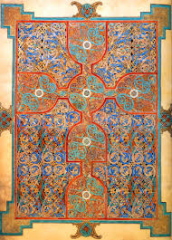
#55 Lindisfarne Gospels -Early medieval Europe/ Hiberno Saxon -c. 700 CE
Content: -illuminated manuscript -highly decorated borders -from the north -cover page -
|
Context: The Lindisfarne Gospels are illuminated manuscripts made with colored inks and gold leaf on vellum. Made in the north, they had a zoomorphic style with reoccurring images associated with animals. They also had highly decorated borders influenced by Islamic rugs. At this time illuminated manuscripts were very popular and because of the majority of the populations inability to read, they consisted largely of intricate illustrations.
|
|

#56 Great Mosque/ Great Mosque Plan -Cordoba, Spain/ Umayyad -c.785-786
Content: - mosque built around a Christian church - giant mosque - elements borrowed from roman architecture and hypostyle hall - open space - columns - red and white striped roman arch - minaret (tower representing wealth - buttresses - flying buttress - quibla wall facing towards Mecca - development of key-hole arch (defining element of Islamic take on roman architecture) - no figural representation
|
Context: The Great Mosque of Cordoba shows the growth of the Islamic faith. The mosque was built around a Christian church, the Islamic faith overcoming that of the roman catholic church in Spain. The combination of faiths resulted in a melding of their defining architecture. The mosque uses roman arches, columns, an open space, and flying buttresses for support. But it also incorporates things from Islamic culture like the modification of the roman arch into a key-hole arch, and the use of mathmatical and geometric designs instead of the incorporation of figural representation. The Islamic faith prevents the worship of icons, so there is little to no depiction of living things in their art. Instead they incorporate complex geometric designs and extremely decorative writing. |
|

#57 Pyxis of al-Mughira - Umayyad Dynasty - c. 968 CE
Content: - gift - belonged to al-Mughira - calligraphic Islamic writing - motifs and smbols o royal power - carved ivory
|
Context: This piece is hand carved ivory that was given as a gift to al-Mughira, a royal person during the Umayyad Dynasty. It is intricately carved with symbols like peacocks to represent royal power and authority. The writing around the rim of the Pyxis is calligraphic and is more of a decoration than a functional piece. This is similar to most Islamic art because of the lack of images of living things. |
|
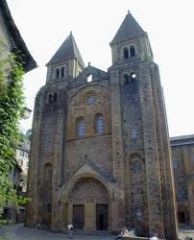
#58 Church of Sainte-Foy - Conques, France/ Romanesque Europe - Church: c. 1050-1130 CE
Content: - westwork (front façade) - two towers - little ornamentation or decoration - very large - massive construction - side isles and barrel vaults - buildings started to be built higher - dome over trancept - radiating chapels surround apse |
Context: The Romanesque era was typically this style of architecture. There is very little decoration because the church was meant to be functional. The church, like many others during this time, was built massive in order to accommodate the massive amounts of pilgrims traveling to see the relics they held. The pilgrims would travel from extremely far away to see items associated with or part of a saint or holy person. |
|
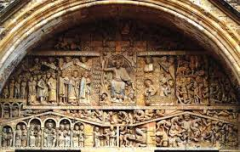
#58 The Last Judgement (tympanum) - Conques, France/ Romanesque Europe - ninth century CE
Content: - decorated half circle above the door - high relief sculpture - depiction of last judgement |
Context: The Last judgment Tympanum is one of the only decorative features of the Church of Sainte-Foy on the façade. It is a relief sculpture depicting the Last Judgment. The sculpture is representative of hell on one side and heaven on the other. In hell there are grotesque figures typical of Romanesque art. The sculpture was made as a message to all pilgrims coming in to the church that how you live in life will affect your afterlife. The sculpture of god looks down on the visitors as they enter, warning against the side of grotesque figures and hell. The pilgrims were meant to be awe-struck as they entered the massive church. |
|
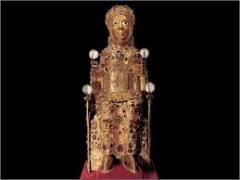
#58 Reliquary of Saint Foy - Conques, France/ Romanesque Europe - ninth century CE
Content: - sculpted container that held the relic - wooden core - gold and silver gilded on top - semi precious stones |
Context: The reliquary of Saint Foy is the main reason why pilgrims would stop at the Church of Saint Foy. Pilgrims traveled such great distances to churches in order to see and be blessed by the relics of saints or holy people. The more valuable the relic, the more popular the church would be for pilgrims. The Church of Saint Foy used a reliquary to hold the relic inside. It was valued by the church because it was their main attraction for the traveling pilgrims. |
|

#59 Bayeux Tapestry - Romanesque Europe/ (English or Norman) - c. 1066-1080
Content: - Anglo-Saxon (English) - battle of Hastings - over 70ft long - woven linen with stitched details
|
Context: The Bayeux Tapestry was created as documentation of the battle of Normandy. The battle united England and France under one rule, making the dukes of Normandy (France) kings of England. The tapestry depicts all the events leading up to, during, and after the battle in a linen creation more than 70ft long. |
|
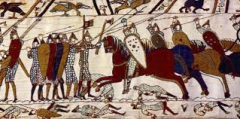
#59 Bayeux Tapestry: Cavalry Attack - Romanesque Europe/ (English or Norman) - c. 1066-1080
Content: - center register - two borders - 8 colors of dyed yarn |
Context: This part of the tapestry depicts part of the battle. 8 colors of dyed yarn are used to show the battle where men on horses (the cavalry) attack men on foot with brightly colored shields. The artist left the linen background to function as the skin of the figures instead of using colored yarn for their skin. The small amount of overlapping of the figures is similar to some mosaics during the roman empire. |
|
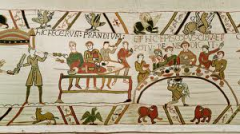
#59 Bayeux Tapestry: The First Meal - Romanesque Europe/ (English or Norman) - c. 1066-1080
Content: - end of the tapestry - figures eating a meal together |
Context: The First Meal section of the Bayeux Tapestry depicts the meal after the end of the battle of Hastings, showing the Anglo-Saxons and Normans eating together around a table. This section serves as the conclusion of the narrative, ending on a note of unity and power. Within the images are icons associated with royal families and power and the visual imagery is supported by text created by yarn. The conclusion symbolizes the formation of one of the strongest kingdoms in Western Europe during the Romanesque period. |
|
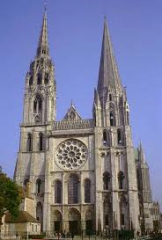
#60 Chartres Cathedral -Chartres, France/ Gothic Europe - original: c. 1145-1155 - reconstructed: c. 1194-1220
Content: - west work (façade/ front entrance) 3 portals (doors) - two towers with high spires - 3 part elevation - pointed arches - ribbed vaults |
Context: The Chartres Cathedral is a perfect representation of Gothic architecture. Built in France (the birthplace of Gothic architecture), it combines some classical ideas with new ones. Instead of roman arches, there are pointed arches and ribbed vaults. The architecture was meant to leave an impression on the visitor with elaborate and mathematical designs, and intimidating jamb statues of past kings and queens that became the standard for gothic architecture. There is a prevailing pattern of threes in the front doors and the levels, symbolizing the holy trinity. |
|
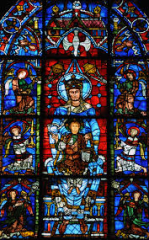
#60 Notre Dame de la Belle Verriere window -Chartres, France/Gothic Eutope -original: c. 1145-1155 - reconstructed: c. 1194-1220
Content: -stained glass window - on front façade of Chartres Cathedral |
Context: The Chartes Cathedral was one of the first examples of stained glass windows. This later became characteristic of gothic churches. The Chartes Cathedral's windows are particularly vibrant and depict the biblical scenes with detail.
|
|
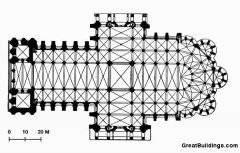
#60 Chartres Cathedral plan -Chartres, France/Gothic Europe - original: c. 1145-1155 -reconstructed: c. 1194-1220
Content:
|
Context: The Chartres Cathedral is based off of a basic Basilica Plan with a transept, typical of the style during the time. The transept made the church resemble the shape of a cross. The plan also contains radiating cathedrals that held relics and statues for the church. This plan became the standard for gothic cathedrals. |
|
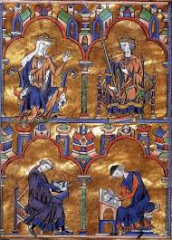
#61 Dedication Page with Blanche of Castile and King Louis IX of France and Scenes from the Apocalypse, from a Bible moralisee - Gothic Europe - c. 1226-1234 CE
Content: -ornamented bible -illuminated manuscript |
Context: The Dedication Page with Blanche of Castile pictures the four people who had a hand in putting it together, the patron, the tutor, the scribe, and the student. Blanche of Castile commissioned the illuminated manuscript for her son, King Louis IX. She used her power and authority to ensure his reign after her death. |
|
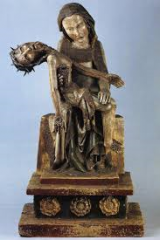
#62 Rottgen Pieta - Late medieval Europe - c. 1300-1325 CE
Content: - after Christ is taken down from cross - Mary weeping - (pieta) - painted wood - statue for a chapel - German |
Context: The Rottgen Pieta is a statue made of painted wood of the scene from the bible when Christ was taken down from the cross and the Mary holds him (Pieta). Different from most Pietas, the Rottgen Pieta is dark and grotesque. This comes from the influence of German gothic art. German art focused more on the emotional impact of a piece rather than the accurate portrayal of figures. The heads in the statue are abnormally sized to display the emotion of Jesus and Mary's faces. |
|
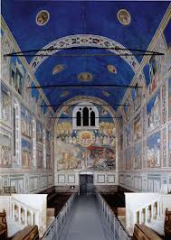
#63 Arena Chapel, including Lamentation - Padua, Italy/ Unknown architect - Giotto (artist) - Chapel: c. 1303 CE - Fresco: c. 1305 |
Context: The Arena Chapel was built as a personal chapel used by a wealthy family. This begins to signify the rise of the wealthy merchant class. The church at this time still held economic and political power, but the wealthy upper/middle class began to commission works of art for themselves. The chapel itself is a basic Basilica plan with an apse and fresco decorations. The artist who painted the frescos was Giotto, who reintroduces the basic 2 dimensional knowledge and composition. In one of the fresco panels, The Lamentation, Giotto uses illusionary depth with a background, middle ground, and foreground. Before this artists had lost the concept of one point perspective and chiaroscuro, which Giotto reintroduces in the Arena Chapel frescos. |
|
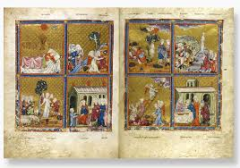
#64 Golden Haggadah - Late medieval Spain - c. 1320 CE
Content: - illuminated manuscript - scenes from Judaism
|
Context: The Golden Haggadah is an illuminated manuscript depicting the events in a Jewish holiday. The three main religions at the time being Christianity, Judaism, and Islam signifies the switch to dominating monotheistic religions. |
|
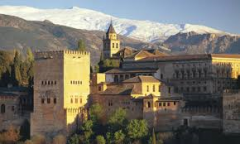
#65 Alhambra Palace -Granada, Spain/ Nasrid Dynasty - 1354-1391 CE
Content: - named for rose colored stone - 23 towers - massive palace - spain |
Context: Symbolized the spreading power of islam, especially in Spain. The palace was built large and ornate with geometric decorations and out of a rose colored stone that it was named after. As the religions influence grew in Spain, so did the architecture associated with it.
|
|
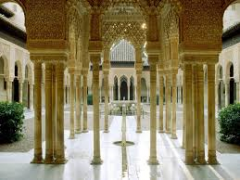
#65 Court of the Lions -Granada, Spain/ Nasrid Dynasty - 1354-1391 CE
Content: - empluvium (water in center of the courtyard) - pointed Islamic arch - greek columns - roman arches - colonade - cloisters - geometric and textual decorations |
Context: The court of the lions contains many classical architectural elements with an Islamic influence. Instead of roman arches there are pointed Islamic arches. Much like earlier greek homes, the court contains an empluvium (a water feature in the center of the courtyard). Because water is so significant in Islamic religion, water features were prominent in the design of the Alhambra palace. |
|

#65 Hall of the Sisters -Granada, Spain/ Nasrid Dynasty - 1354-1391CE
Content: - hallway - water features - dome - geometric and textual decoration - combs on ceiling - claristory windows |
Context: The hall of the sisters is a long hallway containing water features, as well as impressive domes and ornamentation. The dome in the center is decorated with combs similar to stalactites in caves. Because there is little to no figural representation in Islamic art, the entire palace was lavishly decorated and ornamented with geometric and mathematical designs as well as the integration of writing. |
|
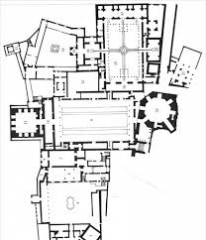
#65 Alhambra Palace plan - Granada, Spain/ Nasrid Dynasty - 1354-1391 CE
Content: - no real organization to the plan - court of the lions clearly distinguishable |
Context: The plan for the Alhambra Palace has little to no organization, though the prominent areas in the palace are easily recognizable from the plan. |
|
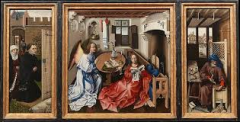
#66 Annunciation Triptych (Merode Altarpiece) - Workshop of Robert Campin - 1427- 1432 CE
Content: - altarpiece - triptych (three paneled piece) - painting - egg-tempra paint on wood paneling
|
Context: The merode altarpiece was commissioned by wealthy Christians. The triptych is painted with a return to humanism used in classic art. In greek style, the artist uses chiaroscuro in the fabrics shown in the piece and an understanding of the human figure less present in earlier works of art. |
|
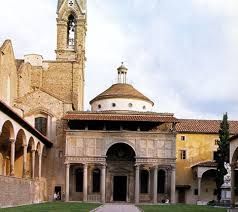
#67 Pazzi Chapel - Basilica di Santa Croce in Florence, Italy/ Filippo Brunelleschi (architect) - c. 1429- 1461 CE
Content: - central plan - roman arch - alter/ apse - creamy white and grey/green |
Context: The structure and interior of the pazzi chapel became the definition of italian architecture. The creamy white and grey/ green colors used on the interior make the Pazzi Chapel and Brunelleschi's work easily identifiable. |
|
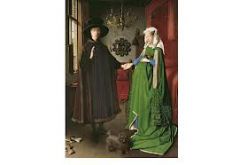
#68 The Arnolfini Portrait - Jan van Eyck - c. 1434 CE
Content: - portrait of a couple - artist included in mirror reflection - 2ft 9in x 2 ft - oil painting on wood |
Context: The Arnolfini portrait is one of the first pieces where the artist inserted himself into the painting. Jan van Eyck is visible in the reflection from the mirror in the background of the portrait. This insertion of an artist into his piece is largely the result of the growing power that artist had over their own work. Though they were commissioned, artists began to develop their own style and terms for the work of art. The artists freedom grew exponentially because of this. |
|

#69 David - Donatello - c. 1440-1460 CE
Content: - bronze sculpture - 5ft 2in - story of David and Goliath - contraposto - southern/ italian |
Context: Donatello's David is a symbol of southern/italian power. At this time the Roman Catholic church was largely in control of economic and political power, however, Italy and the Medici family stood as an opposing force. The statue is based off of the story of David and Goliath from the bible, where a young boy is able to defeat a giant. The giant is symbolic for the church while David is symbolic of Italy. The statue also represents a return to classical styles like controposto, often associated with the Florentine Renaissance. |
|
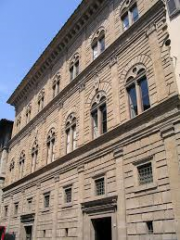
#70 Palazzo Rucellai - Florence, Italy/ Leon Battista Alberti (architect) - c. 1450 CE
Content: - mid-renaissance - a wealthy patron's house - roman arches - post and lintel - columns - levels of columns - horizontal band - large cornice - stone, concrete, and wood |
Context: With the Palazzo Rucellai, Alberti created a new standard and way of building. It symbolizes the rise of wealthy patrons and private citizens commissioning artists and architects for private residences. |
|
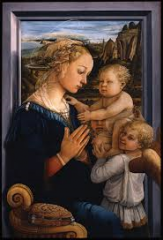
#71 Madonna and Child with Two Angels -Fra Filippo Lippi - c. 1465 CE
Content: - Mary, child, and two angels - tempera on wood - sujestion of halo - aerial perspective - live models |
Context: This piece was created by a monk during the southern mid renaissance. At this time, there were fewer and fewer illuminated manuscripts being made. This lead to an increase in experimentation with materials like tempera on wood and oil on canvas, which later became the widely accepted medium. The piece introduces several new styles typical of the renaissance. The subjects are not engaging the viewer, except for one of the cherubs. Lippi uses a vast sense of depth and space with the use of aerial perspective and a wide range of values that create distance. Also moving away from previous styles, Lippi only creates a very faint halo around the holy figures. |
|
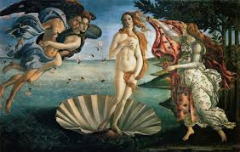
#72 Birth of Venus - Botticelli - c. 1484-1486 CE
Content: - classical myths - aerial perspective - nude - chiaroscuro - contraposto - tempera on wood - 6ft x 9ft |
Context: The Birth of Venus represents a return to the classics. The subject of the painting is the roman god of love, Venus, being born out of the sea. Not only is the subject that of a Greek myth, but Botticelli also brings back concepts like contraposto, and nudity that were indicative of classical art. Unlike most art during its time, the Birth of Venus depicts a scene that doesn't have Christian connotations. This shows the similarities in the ideals of the renaissance and the ideals of ancient Greece and Rome: the depiction of things as they are, and the celebration of the human form. |
|

#73 Last Supper - Leonardo da Vinci - c. 1494-1498 CE
Content: - scene from bible - moment when jesus says one will betray him - fresco in a dining hall for a monastery - experimentation with different fresco methods - oil and tempera on plaster - 14ft X 30ft - extremely large |
Context: The subject of the last supper has been depicted many times, but da Vinci's Last Supper is different because it shows the reaction of the 12 apostles to Jesus telling them, "one of you will betray me". Da Vinci portrays the chaos of the moment, using linear perspective to draw the viewers eye to the calm nature of Jesus in the center. The piece gives the sense of disorder using the techniques being brought back in the renaissance like contraposto and chiaroschuro as well as ones from earlier in Europe like the Orant position.
|
|
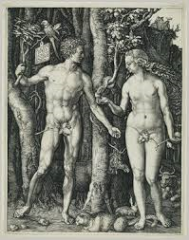
#74 Adam and Eve - Durer - 1504 CE
Content: - davinci of the north - etching into a plate - adam and eve in forest - northern forest - motifs- images representing an ideal - contraposto - eve taking apple from tree - parrot, elk, cow, cat, rabbit, mouse - symbolic? - intaglio- metal plate etching
|
Context: During this time, Durer was considered the da Vinci of the North. The north was beginning to hold a whole new set of artistic styles that reflected the changing power away from the roman catholic church. The protestant reformation was growing especially in the north and Durer was often associated with it. He was considered extremely controversial. He was extremely successful and could be considered an business man. Because of this he was arrogant and often depicted himself like Christ. |
|
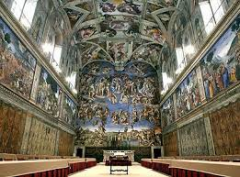
#75 Sistine Chapel ceiling and altar wall frescoes - Vatican City, Italy/ Michelangelo - Ceiling: c. 1508-1512 CE - altar: c. 1536 - 1541 CE
Content: - basic basilica plan - barrel vault - Pope Julius II - less than 4 years - not a lot of experience with fresco
|
Context: The Sistine Chapel is the perfect example of high renaissance. The Chapel represents a return to classic ideas such as humanism that the church uses to inspire viewers. Pope Julius II commissioned Michelangelo to paint the frescos of the chapel to increase the churches power and also to display the power that they already had. |
|
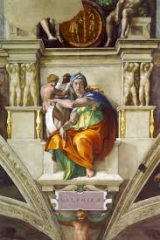
#75 The Delphic Sybil - Vatican City, Italy/ Michelangelo - Ceiling: c. 1508-1512 CE - altar: c. 1536 - 1541 CE
Content: - woman figure - robust figures - melding of architecture and painting
|
Context: The Delphic Sybil section of the Sistine Chapel ceiling fresco embodies much of Michelangelo's technique. Michelangelo painted the woman full, fleshy, and robust, much like he painted most of his human figures. The exaggeration of the human body was common for Michelangelo and for the high renaissance. In this section, Michelangelo also incorporates painted architecture that blends with the actual structure of the Chapel. This creates the illusion of space along with the elaborate chiaroschuro used in the woman's clothes. |
|

#75 The Flood - Vatican City, Italy/ Michelangelo - Ceiling: c. 1508-1512 CE - altar: c. 1536 - 1541 CE
Content: - the flood from the bible - aerial perspective
|
Context: The Flood section of the Sistine Chapel is also characteristic of Michelangelo. The human figures are exaggerated and twisted into numerous positions that were previously unexplored by artists. It also uses aerial perspective with a foreground, middle ground, and background to better tell the story of the flood washing away the sins of man. There is also more painted architecture incorporated in the fresco. |
|
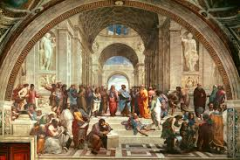
#76 School of Athens - Raphael - 1509-1511 CE
Content: - renaissance fresco - one of four - 19ft x 27ft - Pope Julius II - greatest thinkers - philosophy fresco (out of theology, philosophy, law, and poetry) - elipse
|
Context: This fresco by Raphael was also commissioned by Pope Julius II for his own papal apartments in the Vatican. The elaborate and extravagant techniques used in this painting represent both the ideals of the high renaissance as well as the churches wealth and power. The subject of the painting represents the celebration of classical architecture and thinkers, shown in the depiction of the greatest thinkers of all time like Plato and Aristotle. Raphael also includes himself in the piece, showing the growing power and status of artists during the high renaissance. |
|
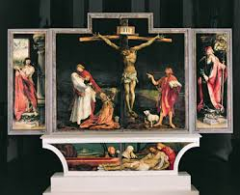
#77 Isenheim altarpiece - Grunewald - c. 1512-1516
Content: - predella (platform) - 3 panels - oil on wood - 1ft x 2ft - german - crusifiction - left st sebastian - right st Anthony - left announcement birth of christ - right resurrection of Christ - middle Christ as a child |
Context: The Isenheim altarpiece is characteristic of what most German art became. The piece, unlike other renaissance pieces, focuses more on conveying emotion rather than representing humanistic ideas. The altarpiece depicts the life of Christ in a more dark and grotesque way than usual. At this time the rise of the protestant reformation continued, especially in the north of Europe.
|
|
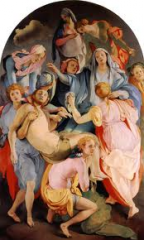
#78 Entombment of Christ - Pontormo - 1525-1528 CE
Content: - focal point in center - early mannerism painting - no symbols - stylized |
Context: Pontormo's Entombment of Christ is one of the early mannerism style paintings. The mannerism style deviated from the normal renaissance styles and created highly stylized and different images. Pontormo's piece depicts the common scene of Christ being taken down from the cross and put in his tomb, but with a different twist. None of the symbols usually incorporated in the scene are there like the cross or the tomb. There is also no earthly setting like in much of the other paintings during this time. Instead, Pontormo creates constant movement throughout the piece, going from one focal point to another. Though the mannerism style wasn't extremely popular, it created a style different from that established with Raphael and Michelangelo.
|
|
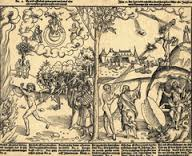
#79 Allegory of Law and Grace - Lucas Cranach the Elder - c. 1530 CE
Content: - print, wood, and oil paintings - wood cut - 11in x 13in - Catholic doctrine vs. Protestant declaration
|
Context: The Allegory of Law and Grace puts into an image the conflicts between religions at the time. The left side is of judgment day. It depicts Catholicism's view that mankind is inherently sinful and that despite the man's best efforts, he has sinned and will be judged based on this. The right side depicts the Protestant view that each man has an individual relationship with Christ. A weak human is shown being saved by gods grace through his crucifixion. This was made 10 years after the posting of Martin Luther's thesis, demonstrating the growing power against the Catholic doctrine in the north and the rise of the Protestant declaration. |
|
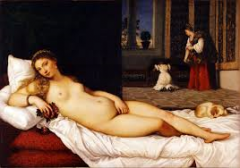
#80 Venus of Urbino - Titian - c. 1538 CE
Content: - Venice - no religious affiliation - referring to woman as a goddess - female reclining nude figure - oil on canvas - chiaroscuro - linear perspective |
Context: This piece of art represents a completely different type of painting compared to the standard of the time. Venus of Urbino was painted in Venice by a venician painter. Venice, because of its geography and its maritime trade, was a separate economic and political power from the rest of Italy. Because Venice was less under the churches control than the rest of Europe, it was able to develop several different approaches to art. The subject of the painting has no religious affiliation unlike most pieces during the time, and though it uses linear perspective and chiaroschuro, it is a completely different color palate specific to Venician art. It also introduces the significant subject in later art of the nude reclining female figure. |
|
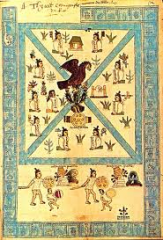
#81 Frontispiece of the Codex Mendoza - Viceroyalty of New Spain - c. 1541-1542 CE
Content: - illuminated manuscript - much like a book with two hard covers - made for new Spanish royalty after nazrid dynasty - documentation |
Context: The Frontispiece of the Codex Mendoza is an illuminated manuscript that demonstrates the interaction between Europe and the New World (the Americas). The manuscript documents the Spanish conquest of Mexico for Spanish royalty. The style is heavily influenced by meso-American/ Aztec culture because of an Aztec artist's involvement in its making. |
|
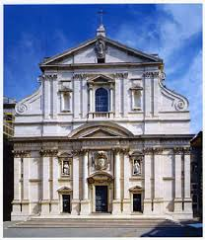
#82 Il Gesu, including Triumph of the Name of Jesus ceiling fresco - Rome, Italy/ Giacomo da Vignola, plan (architect) - Giacomo della Porta, façade (architect) - Giovanni Battista Gaulli, fresco and stucco figures - Church: 16th century - Façade: 1568-1584 - Fresco and stucco figures: 1676-1679 CE
Content: - made by several artists - ceiling fresco - in style of southern baroque art - church - name of Christ within the fresco |
Context: Il Gesu is a perfect example of southern renaissance. At this time the protestant reformation was rising and the church began the counter reformation. The church used art and architecture to regain power as well as display their current power. Il Gesu was given a new façade with some classical elements along with new aspects like the scrolls on the corners. The new façade was made to make churches look more impressive and awe-inspiring to convince people of the churches power. In the inside, there is one of the most elaborate frescos of the Baroque era. Because of the counter-reformation, the Baroque period was all extremes and brightly colored, elaborate paintings. The Il Gesu ceiling fresco uses tricks of the eye and amazingly vibrant colors to inspire viewers. It includes painted architecture as well as painted shadows to make it appear as though there is no ceiling and the viewer is looking up into the heavens. This type of art was used as propaganda for the power of the roman catholic church. |
|
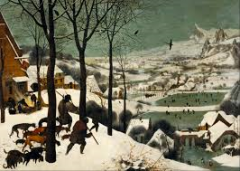
#83 Hunters in the Snow - Pieter Bruegel the Elder - 1565 CE
Content: - depicts very normal scene - northern baroque - intimate and casual - aerial perspective - stark and basic shapes - northern European landscape - dutch |
Context: This piece represents the ideals of the Protestant reformation. The protestants believed that one could gain salvation through a personal relationship with Christ, not a relationship through the church. As a result, most art from protestant regions like the north are not subjects like elaborate scenes from the bible, but of common everyday life. It focuses on normal people and their lives, but also contains proverbs and morals within them. The artist uses stark and basic shapes along with aerial perspective to depict the normal life of a protestant. |
|
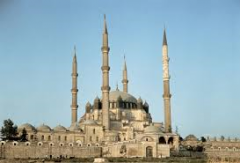
#84 Mosque of Selim II - Edirne, Turkey/ Sinan (architect) - 1568-1575
Content: - islamic - domes, flying butresses - four minerettes - clustered columns - lights hung from wires - mathematical and geometric patterns |
Context: The mosque of Selim II was created by one of the most revered muslim architects, Sinan, in order to rival the innovations of Christian architecture. As architecture changed in Europe, Islamic architecture also became bigger and more impressive. In order to prove this, Sinan the Great made the mosque to match any innovation of any Gothic Cathedral. The Mosque used 4 minerettes to symbolize the extreme wealth and power of the region. |
|
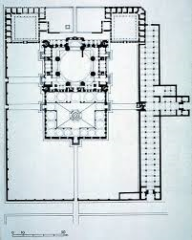
#84 Mosque of Selim II Plan - Edirne, Turkey/ Sinan (architect) - 1568-1575
Content: - standard for architecture - classical elements - true to original design |
Context: The Mosque of Selim II's was the basic standard for most Mosques and was influenced by the Great Mosque of cordoba. The fact that it was not built around a Christian church and is completely Islamic architecture supports the goal to match any gothic architecture. |
|
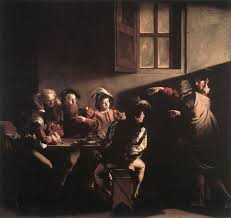
#85 Calling of Saint Matthew - Caravaggio - c. 1597-1601
Content: - depicting Christian scene - oil on canvas - 11 X 11 - saint called by jesus to do gods work - grace of god - symbolism - Levi who becomes st Matthew |
Context: This piece depicts the story of Levi being called by Christ to do the lords work and him becoming Saint Matthew. This piece is different from paintings at the time because it is not extravagant or extremely awe-inspiring. However, Caravaggio uses techniques to portray the story and the symbolism in the story. He uses dramatic lighting to symbolize the grace of god touching Levi. He also puts chirst off to the side instead of his usual front-and-center role in a painting. This represents the steady change from the standard way of painting during the renaissance. |
|
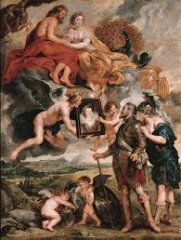
#86 Henri IV Recieves the Portrait of Marie de' Medici, from the Marie de' Medici Cycle - Peter Paul Rubens - 1621-1625 CE
Content: - from series of 20 - 13 X 10 - between southern and northern baroque - open subject matter - portrait of marie de medici given to henri IV - documentation of Marie's life |
Context: This piece represents the over-the-top style that art becomes in Baroque art, as well as the over-the-top lifestyles of royalty. This piece was from a series of 20 and is a combination of southern and northern styles. The subject matter is open and not confined to religious scenes and was made to document Marie de' Medici's life. The piece was made in Flanders that changed from Spanish to Dutch, giving it aspects of both northern and southern art. |
|
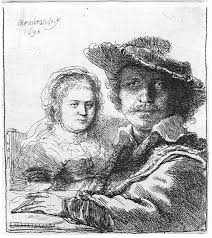
#87 Self-Portrait with Saskia - Rembrandt - 1636 CE
Content: - artist part of subject - marriage portrait - etching (metal plate with wax) - from group of portraits |
Context: In northern art, the artist begins to become a subject. Because of the protestant reformation art began to explore different subjects, and moved away from religious scenes. |
|
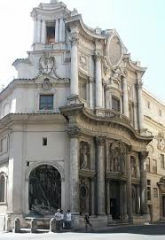
#88 San Carlo alle Quattro Fontane - Rome, Italy/ Francesco Borromini (architect) - 1638-1646 CE
Content: - private residence - southern baroque - 3 stories - classical elements - organic - horizontal plaster - undulated surface - combined chapel and residence |
Context: San Carlo embodies the ideas of southern baroque. The architecture celebrates the classical techniques but uses them in a way that is much more curved and organic. Instead of a pediment, the building had a large horizontal plaster that is characteristic of later italian architecture. The Baroque period was all about extravagance in all forms of art, and San Carlo demonstrates the elaborate details and return to classical ideas of the time. |
|
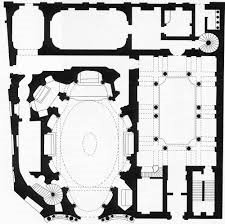
#88 San Carlo alle Quattro Fontane Plan - Rome, Italy/ Francesco Borromini (architect) - 1638-1646 CE
Content: - dealing with lot available - multiple entrances - 2 apses - oval shape - change of stiff formality |
Context: Because of its location and the restrictions from the building lot available, the building was constructed in an oval shape. This was an immense change from the stiff formality of structural plans at the time.
|
|
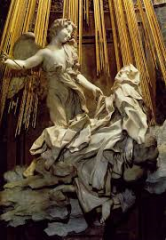
#89 Ecstasy of Saint Teresa - Cornaro Chapel - Church of Santa Maria della Vittoria - Rome, Italy/ Gian Lorenzo Bernini - c. 1647-1652 CE
Content: - statue for church - created stage for statue - Teresa allows gods faith to pierce her - southern baroque |
Context: The Ecstasy of Saint Teresa is another example of the counter reformation and exemplifies Baroque sculpture. The southern style of the sculpture is extravagant and awe-inspiring, meant to portray the story of Teresa being overcome with god's grace. This is a form of propaganda to increase the churches power. |
|

#90 Angel with Arquebus, Asiel Timor Dei - Master of Calamarca (La Paz School) - c. 17th century CE
Content: - painting on a wall - androgynous angel - European dress - roman military boots - archangel - gun/muzzle - Spanish royalty dress
|
Context: The Angel with Arquebus reflects Europe's connection to the colonial Americas. At this time, there was an immense exchange of ideas between places like Spain and Mexico. |
|
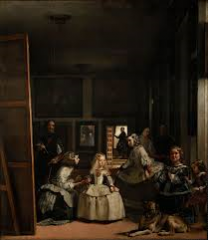
#91 Las Meninas - Diego Velazquez - c. 1656 CE
Content: - portrait with reversed perspective - artist pictured - royal family - attendants - dwarves
|
Context: Las Meninas indicates how the artist became more and more powerful compared to the patron. In this portrait, the artist is depicted more clearly than the king and queen of Spain. |
|
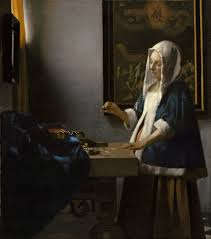
#92 Woman Holding a Balance - Johannes Vermeer - c. 1664 CE
Content: - northern baroque - valuables laid out in front of a mirror - woman holding a balance - religious painting in background - dramatic light source - mirror |
Context: This painting contains many characteristics associated with the developing northern artistic style. Because of the Protestant ideals and views many works of art's subject was of normal, intimate scenes instead of extravagant scenes from the bible. This piece reflects the artists view on balance in life and religion. It includes specific images to be symbolic of balance. |
|
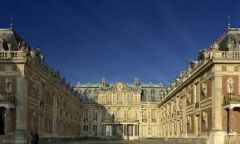
#93 The Palace at Versailles - Versailles, France - Louis Le Vau and Jules Hardouin- Mansart (architects) - Begun 1669 CE |
Context: The Palace at Versailles was made by kings Louis XIV as an alternative center of government from Paris. The palace was constructed at the same time as the Louvre, both symbolizing the power and wealth of the French monarchy. The people of France resented this because of the starvation and poverty they were suffering while the monarchy was living lavishly with a party almost every night. |
|

#93 Courtyard - Versailles, France - Louis Le Vau and Jules Hardouin- Mansart (architects) - Begun 1669 CE |
Context: The courtyard of the palace is in the very front of the building, with the kings bedroom looking out on it. The three paths That go through the small city all lead to converge at the royal courtyard and the kings bed room. The courtyard and the rest of the palace has gilded gold ornamentation everywhere, once again representing the wealth of the monarchy and the excessive nature of the palace. |
|
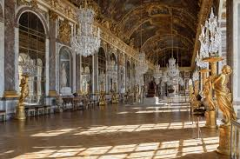
#93 Hall of Mirrors - Versailles, France - Louis Le Vau and Jules Hardouin- Mansart (architects) - Begun 1669 CE |
Context: The Hall of Mirrors is a simple barrel vaulted hallway with one side of windows looking out onto the formal garden and the other side made of mirrors. This hallway is one of the most decorated areas of the palace, with excessive amounts of gilded gold and furniture like statues, chandaliers, couches, and benches. The hall set the standard for some French architecture like the signature French windows. The hallway also exemplifies the extravagance of Baroque art with all of the over the top decorations and elaborate details. |
|
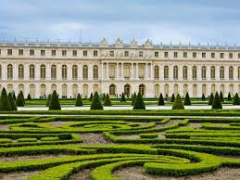
#93 Gardens - Versailles, France - Louis Le Vau and Jules Hardouin- Mansart (architects) - Begun 1669 CE |
Context: The Gardens at Versailles are influenced by the cut and controlled style of English gardens. This once again represents the control and power of the French monarchy at the time. |

